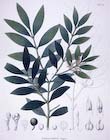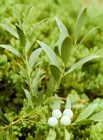
Illustration by Siebold and Zuccarini (1835).

A large tree (83 cm dbh, 15 to 20 m tall) growing at a small shrine in the town of Higashi Fukuma, Fukuoka Prefecture, Japan. The tree is thought to contain a kami, or god [Tom Velardi, 2004].

Tom Velardi with the tree shown above; note the red-brown, platy bark [Tom Velardi, 2004].

Foliage on a tree at the Univ. of Florida, Gainesville [Dan Skean 1985].

Nageia nagi
(Thunb.) Kuntze 1891
Common names
ナギ (Japanese; nagi or naki), 竹柏 (Chinese), Kim giao núi đất (Vietnamese).
Taxonomic notes
Synonymy:
- Myrica nagi Thunb. 1784;
- Podocarpus nageia R. Br. ex Endl. 1847;
- Podocarpus cuspidatus Endl. 1847;
- Podocarpus grandifolius Endl. 1847;
- Nageia cuspidata (Endl.) Gordon 1858;
- Nageia grandifolia (Endl.) Gordon 1858;
- Nageia ovata Gordon 1862;
- Podocarpus ovatus (Gordon) Henkel et W. Hochst. 1865;
- Dammara veitchii Henkel et W. Hochst. 1865;
- Podocarpus caesius Maxim. 1871;
- Nageia caesia (Maxim.) Kuntze 1891;
- Podocarpus nagi (Thunb.) Pilg. var. ovatus (Gordon) Makino 1903;
- Podocarpus nagi (Thunb.) Pilg. var. caesius (Maxim.) Makino 1903.
- Agathis veitchii (Henkel et Hochst.) Seward et Ford 1906;
- Podocarpus formosensis Dummer 1912;
- Podocarpus nankoensis Hayata 1917;
- Podocarpus nagi (Thunb.) Pilg. var. koshunensis Kaneh. 1931;
- Podocarpus formosensis Dummer var. koshuensis (Kaneh.) Merr. & Yamam. 1935;
- Podocarpus koshunensis (Kaneh.) Kaneh. 1936;
- Decussocarpus nagi (Thunb.) de Laub. 1969;
- Decussocarpus nagi (Thunb.) de Laub. var. formosensis (Dummer) Silba 1985;
- Nageia formosensis (Dummer) C.N. Page 1989;
- Nageia nagi (Thunb.) Kuntze var. formosensis (Dummer) Silba 1985;
- Nageia nagi (Thunb.) Kuntze var. koshuensis (Kaneh.) D.Z. Fu 1992;
- Nageia nankoensis (Hayata) R.R. Mill 1999.
Type not designated. Farjon (2010) notes that there have been three Taiwanese species described, but reduces N. formosensis and N. nankoensis to synonymy on the basis of phenotypic plasticity in this species. Molecular studies are needed to resolve the matter further.
Description
Evergreen tree 20-30 m tall and 80 cm dbh, with straight bole. Bark brown-violet, irregularly flaky and 1eaving spline-shaped or somewhat rectangular flake-scars on trunks, flakes about 1.5 mm. thick, more or less woody; lenticels grayish brown, about 0.8 mm across, longitudinally sparsely arranged; outer bark about 0.3 mm. thick, membranous, cross-section of outer bark brown; phelloderm very conspicuous; inner bark about 7 mm. thick, pale yellowish white, fibrous, with flimsy white streaks of parenchymatous tissues; cambium and newly formed phloem colorless, more or less transparent. Freshly cut sapwood pale apricot yellow; wood rays thready, not very much distinct. Branches grey-brown and cylindrical. Young branchlets green, angular. Leaves simple, opposite, coriaceous or thick chartaceous, lanceolate oblong-elliptic to lanceolate-ovate, 4-6 cm long and 1-4 cm wide, acute at tip, gradually tapering at base into a short petiole, with numerous, parallel nerves; dark green and glossy above, paler beneath. Male cones in clusters of 3-5, catkin-like, pedicel about 2 cm long, bracts triangular, few at the base. Stamens numerous, anther 2-celled. Female cone at axil of previous-year-branch, pedicel not swollen. Seeds globose, 10-15 mm wide, seed-coat bluish green, fleshy, covered with white powder, dark violet when mature, without fleshy receptacles; stalk 7-l5 mm long (Liu 1970, FIPI 1996).
Distribution and Ecology
Japan, China and Vietnam; introduced in Taiwan. In Vietnam, it is rare in Lang Son (Trang Dinh), and in some places of the North, growing in tropical evergreen broad-leaved forest, on hills or mountains, below 1000 m elevation (FIPI 1996). Based on data from 19 collection localities, it grows at elevations of 201 ±198 m. Within its range, mean annual temperature is 16.7°C, with an average minimum in the coldest month of 4.3°C, and a mean annual precipitation of 1973 mm (Biffin et al. 2011, Table S5). Hardy to Zone 8 (cold hardiness limit between -12.1°C and -6.7°C) (Bannister and Neuner 2001).
It is a shade-tolerant tree when young, but when mature, may become a canopy dominant. Suitable on feralitic, deep and fertile, loamy-sandy soils (Liu 1970, FIPI 1996).
This species is classified as endangered in Vietnam (FIPI 1996).
Remarkable Specimens
No data as of 2023.02.21.
Ethnobotany
The wood is yellowish with straight veins and fine structure. It is easy to work, not fissured and deformed after seasoning. Uses include construction, making of musical instruments and woodcarving. The oil content in seeds is 30%, and in nut is 50%; this oil is used in lighting and in industry (FIPI 1996).
Observations
No data as of 2023.02.21.
Remarks
The epithet is Thunberg's Romanization of the Japanese common name for this species, ナギ.
The top illustration at right is from the first installment of Siebold and Zuccarini's Flora Japonica, issued in 1835. Philipp Franz von Siebold visited Japan from 1823-1829 as a doctor and scientist in the employ of the Dutch East India Company. During this time he collected thousands of plant and animal specimens, many of new species that were later named for him. Among the conifers, he is commemorated by Tsuga sieboldii.
Citations
See also
Huang 1994 (the Flora of Taiwan).




